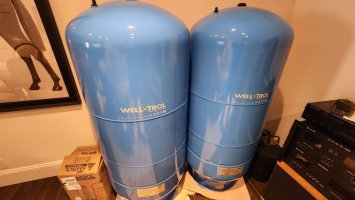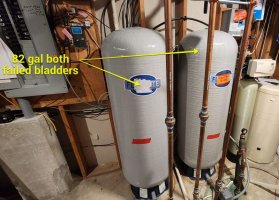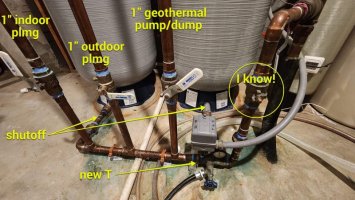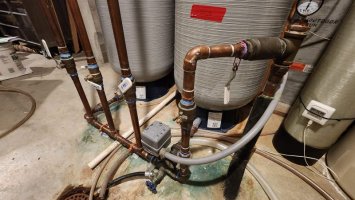dryhero
New Member
Long time lurker and over-thinker. Mad respect for the Terry Love forum, I consider it the most competent, old-school experts with wrenches older than some plumbers. What also draws me in are the elegant solutions members come up with.
Both of my 82 gal. pressure tank bladders failed (months apart). The system seriously gives me night sweats. Time to repair but I want it to be a thing to marvel at. No regrets, no shortcuts. Something a plumber would have in his own home. (Well, maybe not all plumbers.) I've been smoking copper and melting valve seals for decades so trust me when I say, I know enough about plumbing to know that I don't know squat about plumbing. I'm paying an old, retired (emphasis on tired) plumber to help with all the important surgery. He had his own small well business for decades so he hates people. I'm lucky to have his help. I'll do the heavy, ugly work, knock things over and to a lesser extent, block his light.
Hoping for input from the TL Genius Network. Best practices, unique approaches or just really smart twists to this old concept.
What we're working with:
1. 4 year old Goulds 1.5HP 2 wire pump about 90' deep, 1.25" from pump into basement
2. Family of 5 with 2 geothermal pump and dump units (3 ton @ roughly 4.5 gpm and 1 ton at 1.5 gpm)
Have 2 Well-X-Trol WX-350 replacement tanks (26" dia vs 21.5" dia Flex Lite...valveman is already putting duct tape around his head)
3. Plan to install new pressure T (brass or stainless?) with boiler drain, 100 psi pressure gauge and relief valve
4. Plan to replace check valve
5. Plan to leave deadhead shut off before pressure switch (handle removed, so I don't have to drain the entire well supply)
Considered installing shut-offs to each tank to isolate "just in case"
6. Would like to install cycle stop valve with by-pass loop "just in case"
7. Add pressure gauges at each supply line (inside, outside, geothermal)
8. There is a sediment filter plumbed in before the geothermal
9. Is there a good temperature gauge (for geothermal supply temp.)?
10. Ever install a permanent pressure gauge on the pressure tank schrader valve?
11. Blue Gorilla tape is my botch job...I will NEVER do that way again.
12. I like using unions for flexibility, but mostly because I lack confidence. Are they ok to use?
13. I've learned to use FNPT fittings vs MPT at pressure T
14. Is there a best way to tie in both pressure tanks?
15. Is there a best way to tie in stop cycle valve?
16. Are there pressure monitors/alerts for any of this
17. Currently no expansion tank, but will be added at time of 1983 water heater replacement
18. Does anybody place something between the tank and floor to create a capillary break, prevent rust?
19. Switch is also 4 years old...have a backup on the shelf
20. Plan to set cut in/out pressure to 40/60 again (2nd floor showers run a bit slow so dialed it up to 50-70)
Both of my 82 gal. pressure tank bladders failed (months apart). The system seriously gives me night sweats. Time to repair but I want it to be a thing to marvel at. No regrets, no shortcuts. Something a plumber would have in his own home. (Well, maybe not all plumbers.) I've been smoking copper and melting valve seals for decades so trust me when I say, I know enough about plumbing to know that I don't know squat about plumbing. I'm paying an old, retired (emphasis on tired) plumber to help with all the important surgery. He had his own small well business for decades so he hates people. I'm lucky to have his help. I'll do the heavy, ugly work, knock things over and to a lesser extent, block his light.
Hoping for input from the TL Genius Network. Best practices, unique approaches or just really smart twists to this old concept.
What we're working with:
1. 4 year old Goulds 1.5HP 2 wire pump about 90' deep, 1.25" from pump into basement
2. Family of 5 with 2 geothermal pump and dump units (3 ton @ roughly 4.5 gpm and 1 ton at 1.5 gpm)
Have 2 Well-X-Trol WX-350 replacement tanks (26" dia vs 21.5" dia Flex Lite...valveman is already putting duct tape around his head)
3. Plan to install new pressure T (brass or stainless?) with boiler drain, 100 psi pressure gauge and relief valve
4. Plan to replace check valve
5. Plan to leave deadhead shut off before pressure switch (handle removed, so I don't have to drain the entire well supply)
Considered installing shut-offs to each tank to isolate "just in case"
6. Would like to install cycle stop valve with by-pass loop "just in case"
7. Add pressure gauges at each supply line (inside, outside, geothermal)
8. There is a sediment filter plumbed in before the geothermal
9. Is there a good temperature gauge (for geothermal supply temp.)?
10. Ever install a permanent pressure gauge on the pressure tank schrader valve?
11. Blue Gorilla tape is my botch job...I will NEVER do that way again.
12. I like using unions for flexibility, but mostly because I lack confidence. Are they ok to use?
13. I've learned to use FNPT fittings vs MPT at pressure T
14. Is there a best way to tie in both pressure tanks?
15. Is there a best way to tie in stop cycle valve?
16. Are there pressure monitors/alerts for any of this
17. Currently no expansion tank, but will be added at time of 1983 water heater replacement
18. Does anybody place something between the tank and floor to create a capillary break, prevent rust?
19. Switch is also 4 years old...have a backup on the shelf
20. Plan to set cut in/out pressure to 40/60 again (2nd floor showers run a bit slow so dialed it up to 50-70)




